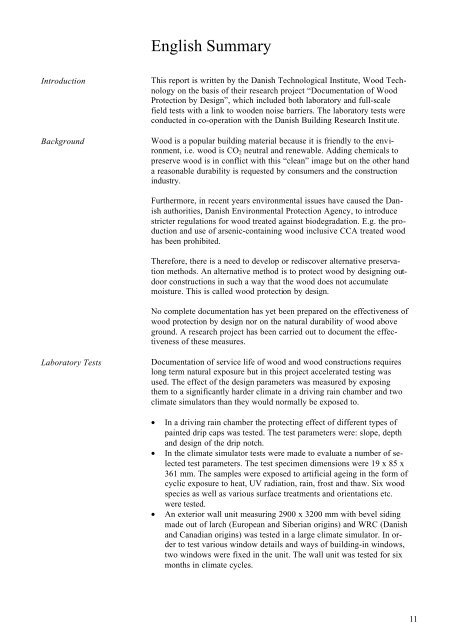PDF-format - Miljøstyrelsen
PDF-format - Miljøstyrelsen
PDF-format - Miljøstyrelsen
Create successful ePaper yourself
Turn your PDF publications into a flip-book with our unique Google optimized e-Paper software.
Introduction<br />
Background<br />
Laboratory Tests<br />
English Summary<br />
This report is written by the Danish Technological Institute, Wood Technology<br />
on the basis of their research project “Documentation of Wood<br />
Protection by Design”, which included both laboratory and full-scale<br />
field tests with a link to wooden noise barriers. The laboratory tests were<br />
conducted in co-operation with the Danish Building Research Instit ute.<br />
Wood is a popular building material because it is friendly to the environment,<br />
i.e. wood is CO2 neutral and renewable. Adding chemicals to<br />
preserve wood is in conflict with this “clean” image but on the other hand<br />
a reasonable durability is requested by consumers and the construction<br />
industry.<br />
Furthermore, in recent years environmental issues have caused the Danish<br />
authorities, Danish Environmental Protection Agency, to introduce<br />
stricter regulations for wood treated against biodegradation. E.g. the production<br />
and use of arsenic-containing wood inclusive CCA treated wood<br />
has been prohibited.<br />
Therefore, there is a need to develop or rediscover alternative preservation<br />
methods. An alternative method is to protect wood by designing outdoor<br />
constructions in such a way that the wood does not accumulate<br />
moisture. This is called wood protection by design.<br />
No complete documentation has yet been prepared on the effectiveness of<br />
wood protection by design nor on the natural durability of wood above<br />
ground. A research project has been carried out to document the effectiveness<br />
of these measures.<br />
Documentation of service life of wood and wood constructions requires<br />
long term natural exposure but in this project accelerated testing was<br />
used. The effect of the design parameters was measured by exposing<br />
them to a significantly harder climate in a driving rain chamber and two<br />
climate simulators than they would normally be exposed to.<br />
• In a driving rain chamber the protecting effect of different types of<br />
painted drip caps was tested. The test parameters were: slope, depth<br />
and design of the drip notch.<br />
• In the climate simulator tests were made to evaluate a number of selected<br />
test parameters. The test specimen dimensions were 19 x 85 x<br />
361 mm. The samples were exposed to artificial ageing in the form of<br />
cyclic exposure to heat, UV radiation, rain, frost and thaw. Six wood<br />
species as well as various surface treatments and orientations etc.<br />
were tested.<br />
• An exterior wall unit measuring 2900 x 3200 mm with bevel siding<br />
made out of larch (European and Siberian origins) and WRC (Danish<br />
and Canadian origins) was tested in a large climate simulator. In order<br />
to test various window details and ways of building-in windows,<br />
two windows were fixed in the unit. The wall unit was tested for six<br />
months in climate cycles.<br />
11

















